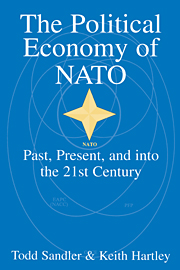Book contents
- Frontmatter
- Contents
- List of tables and figures
- Preface
- 1 NATO at the crossroads: An introduction
- 2 NATO burden sharing and related issues
- 3 On NATO expansion
- 4 NATO and peacekeeping
- 5 NATO and the defense industrial base: EU and USA
- 6 NATO challenges on the horizon
- 7 NATO and Europe
- 8 NATO design
- 9 Conclusions and future scenarios
- References
- Author index
- Subject index
9 - Conclusions and future scenarios
Published online by Cambridge University Press: 05 June 2012
- Frontmatter
- Contents
- List of tables and figures
- Preface
- 1 NATO at the crossroads: An introduction
- 2 NATO burden sharing and related issues
- 3 On NATO expansion
- 4 NATO and peacekeeping
- 5 NATO and the defense industrial base: EU and USA
- 6 NATO challenges on the horizon
- 7 NATO and Europe
- 8 NATO design
- 9 Conclusions and future scenarios
- References
- Author index
- Subject index
Summary
NATO has weathered momentous changes during the last decade and will confront yet further significant events over the next decade. NATO is at a crossroads: it must adjust to an evolving Europe, prepare for its imminent expansion in 1999, procure the next generation of weapons, refigure its forces to promote mobility, and foster increased allied cooperation to offset defense downsizing. For nearly fifty years, NATO has distinguished itself as an enduring institution that has accepted new members and that has altered it military doctrine in response to changing threats. Despite crises within NATO – for example, the Cyprus invasion, the withdrawal of France and Spain from NATO's integrated military command, socialist governments coming to power in some member states – the alliance has survived the Cold War by outlasting the ex–Warsaw Pact in an arms race of attrition that left the Soviet Union's economy in tatters. Although the outcome of the Cold War has been victory for NATO, its allies have still paid for their protracted arms race in terms of opportunity costs. This arms competition has, for example, given Japan a decided advantage in the past, leading to its success in building a vibrant economy that dominates the world markets in numerous commodities. NATO is a noteworthy institution because of its resilience and flexibility. It has been able to respond to changes in weapon technology, strategic doctrine, membership composition, and perceived threat, because it is a “loose” institution that promotes allies' autonomy, while allowing for the pursuit of common interests.
- Type
- Chapter
- Information
- The Political Economy of NATOPast, Present and into the 21st Century, pp. 249 - 268Publisher: Cambridge University PressPrint publication year: 1999



